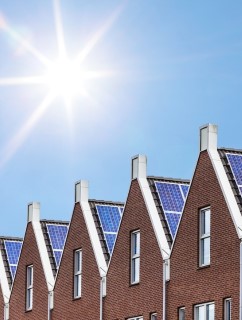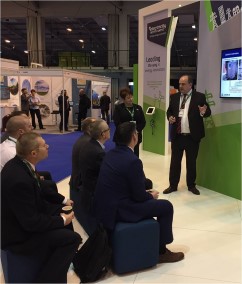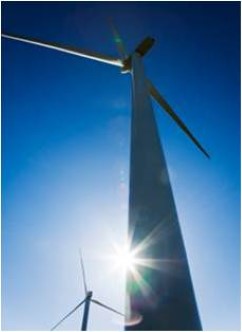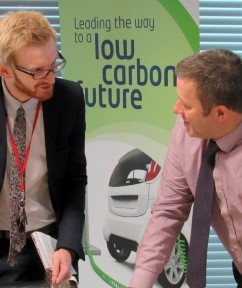Innovation update January 2018
Innovation update January 2018
In our latest quarterly newsletter, we provide an update on some of our key projects and an overview of our involvement at the recent Low Carbon Networks & Innovation conference.
End of the road for Smart Street
 We have now completed our Smart Street trials. Over the next two months we will analyse the results from the project and share our findings with our stakeholders.
We have now completed our Smart Street trials. Over the next two months we will analyse the results from the project and share our findings with our stakeholders.
The £11.5 million Smart Street project trialled innovative voltage control techniques to enable our networks and customers’ appliances to perform more efficiently and make it easier to adopt low carbon technologies onto the electricity network.
During the trials we collected system data over a two-year period which was passed to our academic partners for analysis. This has enabled us to compare Smart Street data with normal network operation and calculate the overall benefits of the project. Initial academic reports published at the halfway point of the trials showed that Smart Street will deliver energy savings by stabilising and reducing voltage but without impacting power quality.
In January and February we are holding a final series of focus groups to understand any impact on the 67,000 customers served by the trial circuits in Manchester, Wigan, Wigton and Egremont. Customers taking part in our previous focus groups confirmed that they hadn’t noticed any changes.
If you would like to find out more about the findings from the Smart Street project we are holding a closedown event on 28 February 2018 in Manchester. Our project closedown report and a series of detailed academic reports will be published on our website in April 2018.
Celsius starts to cool down substations
 This month we are starting to install a range of cooling techniques at substations across the region as part of our pioneering Celsius project. Techniques such as improved ventilation, heat extraction fans and alternative kinds of backfill material for underground cables will be trialled over the next 12 months.
This month we are starting to install a range of cooling techniques at substations across the region as part of our pioneering Celsius project. Techniques such as improved ventilation, heat extraction fans and alternative kinds of backfill material for underground cables will be trialled over the next 12 months.
The cooling techniques will be installed at 100 of the 520 sites where temperature monitoring equipment was installed last year. Data from the substations is being used to understand how the environment and temperature affect the electrical equipment and how cooling can help release more power onto the electricity network.
As the cooling techniques will be deployed at substations close to homes and businesses, we will carry out a programme of engagement to understand any audible or visual impact of the techniques on our customers. A baseline survey will be carried out in January before the cooling techniques are installed.
Celsius will deliver a co-ordinated approach to managing the temperature of electrical assets in distribution substations and is the first solution of its kind in Great Britain. The project will release additional capacity, reduce long-term costs for customers and avoid early asset replacement.
Final reports will show true value of lost load
 Following a detailed programme of research with 6,000 domestic customers and small businesses, our Value of Lost Load project is almost complete.
Following a detailed programme of research with 6,000 domestic customers and small businesses, our Value of Lost Load project is almost complete.
Our survey which included 3,000 customers from the North West and 3,000 from across the rest of Great Britain has provided a much better understanding of the impact a power cut can have on a diverse range of domestic and business customers.
The research shows a huge difference in the way customers value their electricity supply. Working couples are among the least affected by a power cut whereas the customer groups most affected include those with electric vehicles or electric heat pumps, young families, the elderly and the fuel poor.
Understanding this impact or ‘value of lost load’ (VoLL) is important as it is used across the electricity industry to guide investment decisions and the way customers are compensated after a power cut. At present one customer’s power cut is valued the same as another. For example, the impact of a power cut affecting the home of a working couple is valued the same as a nursing home with 100 residents.
The findings from our research will help ensure that future investments are targeted at areas of the network which will benefit our customers the most. It’s also likely to influence how we support vulnerable customers and address fuel poverty.
The results of our customer research and recommendations for the application of VoLL will be made available in two separate reports which will be published on our website in February 2018.
Avatar set to deliver blueprint for customer service
 As a distribution network operator (DNO) we need to understand and predict our customers’ future needs to make sure we maintain and improve our level of service. As we start to use more low carbon technologies our customers will become even more reliant on their electricity supply. Our research tells us that customers’ simply won’t accept supply interruptions for protracted periods and that we need to make a step change in the way we communicate with them.
As a distribution network operator (DNO) we need to understand and predict our customers’ future needs to make sure we maintain and improve our level of service. As we start to use more low carbon technologies our customers will become even more reliant on their electricity supply. Our research tells us that customers’ simply won’t accept supply interruptions for protracted periods and that we need to make a step change in the way we communicate with them.
As part of our Avatar project we are carrying out a programme of detailed customer and stakeholder engagement looking at how customers’ attitudes, behaviours, needs and expectations are likely to change in the future. Working with project partners at the cutting edge of customer service we will learn how best to interact with customers to better understand what information they want from us, in what format and on what platforms.
The next step in the project is to hold a series of focus groups with around 40 customers which will look at customers' needs and expectations and their reaction to prototype and conceptual solutions to a future customer service model.
The findings from the focus groups will be used to develop a blueprint for the implementation of bespoke customer service solutions and begin the evolution of our customer service strategy.
Sharing knowledge at our industry conference
 On 6-7 December our innovation team attended the seventh annual Low Carbon Networks and Innovation Conference (LCNI) at the International Centre in Telford.
On 6-7 December our innovation team attended the seventh annual Low Carbon Networks and Innovation Conference (LCNI) at the International Centre in Telford.
Over 1,000 delegates from across the energy industry attended the two-day event which showcased our industry’s network innovation projects through a programme of over 40 breakout and workshop sessions. We also held smaller ‘on-stand’ presentations to share as much information as possible about our innovation strategy and portfolio of projects.
Our innovation team presented on our key innovation projects including Celsius, Respond and Smart Street. We also discussed some of our smaller-scale projects: Oil Regeneration, ATLAS (Architecture of Tools for Load Scenarios), the Value of Lost Load and Avatar.
You can find out more about the conference and see our slides and literature at www.enwl.co.uk/lcni.
Joining forces for Transition project
 Last year we partnered with fellow DNO, Scottish and Southern Energy Networks, in a bid for Network Innovation Competition funding bid for their Transition project. The aim of Transition is to design and demonstrate the tools needed to deliver the distribution system operator (DSO) models proposed by the ENA’s Open Networks project. This includes building a market model to enable network flexibility and trialling its use in three specific areas. The project aims to de-risk and facilitate the transition from DNO to DSO.
Last year we partnered with fellow DNO, Scottish and Southern Energy Networks, in a bid for Network Innovation Competition funding bid for their Transition project. The aim of Transition is to design and demonstrate the tools needed to deliver the distribution system operator (DSO) models proposed by the ENA’s Open Networks project. This includes building a market model to enable network flexibility and trialling its use in three specific areas. The project aims to de-risk and facilitate the transition from DNO to DSO.
We will participate in the project by conducting one of the trials in our region, enacting demand-side flexibility either by engaging with existing demand and storage customers, or across a DNO boundary.
In November 2017 Ofgem released a conditional funding decision for Transition, and two other DNO-led projects – Fusion (Scottish Power Distribution), and Electricity Flexibility and Forecasting System (Western Power Distribution), as it was determined that there was significant overlap between the scope of the three projects. The project teams will now work together to remove any duplication from the three projects and align the work being carried out under the ENA Open Networks project.
We will continue to work closely with each DNO team during this scoping phase to ensure that the maximum value is gained from the projects.
Useful links
 You can find out more detailed information about our strategy and all of our innovation projects using the following links:
You can find out more detailed information about our strategy and all of our innovation projects using the following links:
- Our innovation strategy: www.enwl.co.uk/innovation-strategy
- Our LCN Fund project Smart Street: www.enwl.co.uk/smartstreet
- Our LCN Fund project Respond: www.enwl.co.uk/respond
- Our NIC project Celsius: www.enwl.co.uk/celsius
- Our NIA projects: www.enwl.co.uk/nia
- Meet the Electricity North West innovation team: Meet the team
- The Electricity Networks Association smarter networks portal: www.smarternetworks.org
Or contact us at innovation@enwl.co.uk.
If you would like to find out about other Electricity North West projects and events please register for our stakeholder newsletter.